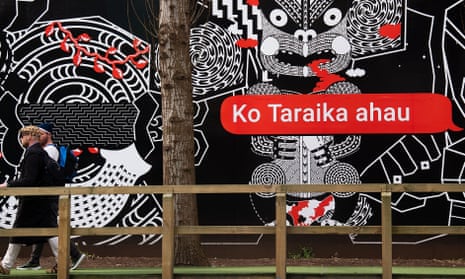This year I am studying a full immersion te reo Māori course at the renowned Te Wānanga o Takiura. Like many other Māori, I’ve spent my adult years using my own time, money, energy, and resources in an attempt to learn the language of my ancestors. A language that was stolen from my whānau because Te Tiriti of Waitangi was not honoured. So here I am, out of complete desperation, trying to reclaim and hopefully become fluent in te reo Māori.
At a glance, it seems New Zealanders are taking an interest in learning reo. The number of teenagers studying te reo Māori at secondary school has passed 30,000 for the first time. Māori Made Easy, a language study book by Scotty Morrison, has become a staple in every household. There are waiting lists across the country to get into part-time te reo classes. If this is the case, why won’t the Labour government commit to making te reo Māori compulsory in schools?
One of the biggest arguments is the lack of public support. I am confused by this. When we say public, who are we talking about exactly? Please show me a whānau Māori who do not want their child to speak their own language. The systems in place seem hell-bent on preventing our tamariki (children) from having access to their own language. Kura kaupapa Māori-language immersion schools are widely underfunded and under-resourced and not accessible to all whānau. The argument that students might be “forced to learn” also places Pākehā at the centre and completely dismisses what is best for Māori. I went through mainstream education but it came at a cost. I became fluent in Pākehā but lost my identity as Māori in the process. Every Māori child deserves access to te reo without the barriers in place.
The lack of Māori teachers is another excuse. To that I say, pay Māori teachers what they are worth. Fund them through university and treat the ability to speak Māori as a gift, a talent and a valuable skill. Because it is. Māori teachers are often expected to be the Kapa Haka tutor, the Tikanga adviser, Māori adviser to the staff, Māori community broker as well as a classroom teacher and yet they are paid the same as their Pākehā counterparts. I have watched my own whānau and friends work tirelessly in these roles only to get burned out and leave.
It is good to see our biggest television media network here in Aotearoa normalising the use of te reo Māori. On the 6pm news, te Reo now extends beyond the usual “kia ora, good evening”. But shouldn’t this be the bare minimum for our publicly funded broadcaster?
A brief glance into our racist history will tell you partly why it has taken so long. In 1984 Dame Rangimarie Naida Glavish was almost fired for saying kia ora at her job at the call centre. In 2004 a Whangārei teenager quit her job after she got in trouble for greeting customers at her work, a frozen yoghurt store, with the words “kia ora”. There has been continual resistance from Pākehā New Zealand over the use of te reo. You only need to look at the comments on social media today to see that.
But it’s not just the racism from the outside. Journalist Aaron Smale has also rightly pointed out that sprinkling Māori terminology over a surface is often an attempt to cover up the colonial and racist system that exists within an institution. For example, this is what Oranga Tamariki has done. Changing its name from the Ministry for Children and giving it a Māori name does not cancel, hide or take away the destructive harm the organisation has caused whānau Māori.
Equally, the media cannot think all they need to do is add te reo. New Zealand mainstream media have never truly honoured Te Tiriti. In 2020, Stuff admitted to this and apologised to Māori, acknowledging that Stuff’s past media coverage had contributed to racism towards Māori. An acknowledgement is a good start.
Only last week, John Banks was taken off air at a radio station after a caller said Māori were, “genetically predisposed to crime, alcohol and underperformance educationally”. Banks doubled down and agreed saying, “these people will come through your bathroom window”.
Greetings in reo are only the beginning. We need more Māori in leadership positions, we need the nurturing and fostering of Māori journalists, we need all reporters, editors and those working in the media industry to study, understand and honour Te Tiriti. So whenever I see a media outlet or any institution make a change, I ask myself is this progression or simply performative?
Because we need more than a sprinkle of te reo. We need actual progressive change.
Shilo Kino (Ngā Puhi, Tainui) is a writer, reporter and author of her debut novel The Pōrangi Boy. She is studying te reo Māori full time this year.
